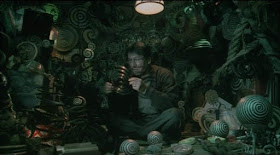When Marnie Was There (Omoide no Mânî) (2014) Probably because it
wasn’t a Takahata or Miyazaki Studio Ghibli film, When Marnie Was There arrived and departed with little fanfare. But
this film only proved the veteran animators aren’t the only formidable talents
at the studio. Director Hiromasa Yonebayashi’s (The Secret World of Arrietty) film, based on a novel by Joan G.
Robinson, is an emotionally gripping tale, filled with beautiful, richly
detailed animation. The story focuses on Anna, a smart, but antisocial and
emotionally detached 12-year-old girl. When her foster mother sends her to live
with relatives she befriends a mysterious young girl named Marnie, who lives in
a decrepit old mansion.
The film displays a level of complexity rarely seen in
American animated films. Although it’s clearly aimed at pre-teen girls, anyone
can relate to its themes of loss, abandonment and emotional isolation. When Marnie Was There takes a refreshing
approach to its troubled protagonist, because it doesn’t force the issue of her
trauma or social anxiety, but lets her story play out naturally. Rather than
tell her what she should do, the adult characters allow Anna to work things out
on her own terms. This is wonderful, thoughtful entertainment for smart kids
(and adults), which declares there’s life in Studio Ghibli yet.
Rating: ****½. Available on Blu-ray and DVD
Goke, Body Snatcher
from Hell (aka: Kyuketsuki Gokemidoro)
(1968) Director Hajime Satô’s fascinating
film takes a dim view of humanity and our propensity for evil. After a hijacked airliner crashes in a remote area, the
survivors must struggle to stay alive until help arrives. The passengers and
crew represent a microcosm of society, representing our capacity for altruism,
greed, selfishness and lust (I wonder if anyone’s ever done a thesis, comparing
the various passengers to the seven deadly sins?). As hope of rescue begins to
dissolve, the passengers begin to squabble under the watchful eye of an alien
spacecraft, which appears to be orchestrating their actions. The film features
some suitably disturbing imagery, as humans are turned into bloodthirsty
zombies, and fear and paranoia become the survivors’ primary motivation. In
spite of the supernatural occurrences, however, it’s evident we don’t require
outside intervention to do ourselves in.
Rating: ****. Available on DVD and Hulu
Sayonara, Jupiter (aka:
Bye Bye Jupiter) (1983) I can’t
really say this film was good, but what it lacks in quality, it makes up in
sheer entertainment value. Co-directors Koji Hashimoto and Sakyo Komatsu (working
from a novel by Komatsu) want Sayonara,
Jupiter to be 2001: A Space Odyssey,
but it’s more like The Black Hole, thanks
to a pervasive combination of silliness and pseudo-science. I won’t profess to
make sense of it all, with its multiple plot threads and story elements, but there’s
enough material for several movies. Researchers hatch a project to turn Jupiter
into a second sun, to provide solar power for the colonies in the outer planets.
A hippie cult that worships a dolphin named Jupiter threatens to bring a halt
to the plans. Meanwhile, there’s evidence of ancient aliens on the surface of Mars
and drifting in Jupiter’s atmosphere. And things get even more complicated when
a black hole threatens to engulf the earth. It’s a glorious mess that must be
seen to be believed, if your brain can stand it (Oh, did I mention there’s a
floating sex scene?).
Rating: **½. Available on DVD
Genocide (aka: War of the Insects) (1968) With its anti-war message, Genocide shares some common themes with Goke, Body Snatcher from Hell, but it’s clumsily told. When an
American bomber has a disastrous run-in with a swarm of insects, the crew bail
out on a remote Japanese island, and their H-bomb payload goes missing. The
U.S. Air Force, local police, and some shady folks race to find the bomb, but
their efforts are hindered by a murder investigation and some nasty bugs. The
film’s primary concept, regarding an evil plan to breed a new deadly species of
insect, is intriguing but it’s derailed by the subplots. The antagonist’s
motivation is also highly suspect, as well as the shaky scientific
explanations. The end result is something that seems half-baked and
unsatisfying.
Rating: **½. Available on DVD and Hulu
Monster X Strikes Back:
Attack the G8 Summit (2008) Writer/director Minoru Kawasaki’s comic semi-sequel
to the 1968 flick The X from Outer Space
is a real disappointment. His kaiju farce has some fleeting moments, but it’s mostly
full of missed opportunities. The star monster, Guilala, has too little screen
time, and too much time is spent with the titular summit. The bickering and
juvenile posturing of the characters provides nothing new in the way of satire,
and brings the film to a screeching halt. Some of the best scenes involved a
wacky Guilala cult, which should have been the focus, rather than a subplot. The
normally reliable Kawasaki has done much better (try the superior Executive Koala, The Calamari Wrestler, or The
Rug Cop).
Rating: **½. Available on DVD
R100 (2014) A disappointing
sex comedy that’s not particularly sexy or funny. Director Hitoshi Matsumoto
never strikes the right tone, vacillating between serious family drama and
slapstick. R100 follows a meager
middle-aged salesman (Mao Daichi) who cares for his young son as his wife lies
in a coma in the hospital. He decides to take a walk on the wild side, and signs
a contract with a BDSM firm. One of the stipulations of the contract is that he
could be visited anytime or anywhere by a dominatrix under their employment. This
becomes a running gag, in which he becomes increasingly aroused with each bizarre
sexual encounter. While some of these scenes are sporadically amusing, they
quickly become repetitive, and the comic effects have diminishing returns. Ultimately,
the biggest factor that undermines the film is the main character, whose sexual
appetite, in light of his situation, makes him appear selfish and unlikeable.
Rating: **. Available on Blu-ray and DVD.



























